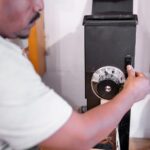Understanding Different Types of Chimneys
Chimneys play a crucial role in heating systems. They safely expel combustion gases from your home. There are various types of chimneys available in the market. Steel chimneys for condensing gas boilers are popular choices. Plastic chimneys for condensing gas boilers offer another option. Each type has its unique benefits. Steel chimneys for pellet boilers are also widely used. Understanding these options will help you make an informed decision.
Chimney materials significantly impact performance. Steel is durable and corrosion-resistant. Plastic is lightweight and easy to install. The choice depends on your specific heating system. Condensing boilers require different chimneys than traditional ones. Pellet boilers have their own requirements. Consider factors like efficiency and longevity when selecting.
Proper sizing is essential for chimney efficiency. A chimney that’s too small can lead to poor draft. One that’s too large may cause condensation issues. Consult with a professional to determine the right size. They’ll consider factors like boiler output and house layout. This ensures optimal performance of your heating system.
Installation methods vary for different chimney types. Chimneys can be installed internally or externally. Internal installation offers better insulation. External installation may be easier in some cases. Professional installation is crucial for safety. It ensures proper sealing and support. Incorrect installation can lead to dangerous gas leaks.
Maintenance requirements differ among chimney types. Steel chimneys need regular cleaning to prevent corrosion. Plastic chimneys require inspection for potential damage. Regular maintenance extends the lifespan of your chimney. It also ensures continued efficiency of your heating system. Schedule annual inspections with a qualified technician.
Advantages of Steel Chimneys
Steel chimneys for condensing gas boilers offer numerous benefits. They withstand high temperatures effectively. Steel chimneys have a long lifespan, often exceeding 25 years. Their durability makes them suitable for various climates. They resist corrosion from acidic condensate produced by condensing boilers.
Installation of steel chimneys is straightforward. They come in pre-fabricated sections for easy assembly. This reduces installation time and costs. Steel chimneys can be retrofitted to existing systems. Their versatility makes them suitable for both new builds and renovations.
Heat retention is a key advantage of steel chimneys. They maintain higher flue gas temperatures. This improves draft and reduces condensation. Better draft leads to more efficient boiler operation. It also helps prevent backdrafting of harmful gases.
Steel chimneys are available in various diameters. Common sizes range from 80mm to 200mm. This variety ensures compatibility with different boiler outputs. Larger diameters are available for commercial applications. Proper sizing is crucial for optimal performance.
Maintenance of steel chimneys is relatively simple. Regular cleaning prevents soot buildup. Inspection for signs of wear or damage is important. Most issues can be addressed with simple repairs. This makes steel chimneys a cost-effective long-term solution.
Benefits of Plastic Chimneys
Plastic chimneys for condensing gas boilers have unique advantages. They’re lightweight, making installation easier. Plastic chimneys are resistant to corrosion from acidic condensate. This makes them ideal for condensing boilers. They’re available in various compositions to suit different applications.
Cost-effectiveness is a major benefit of plastic chimneys. They’re generally less expensive than steel alternatives. Installation costs are often lower due to their light weight. Plastic chimneys don’t require special tools for cutting. This further reduces installation time and expenses.
Flexibility is another advantage of plastic chimneys. They can be easily routed around obstacles. This makes them suitable for complex installations. Plastic chimneys can be installed both internally and externally. They’re available in lengths up to 30 meters for vertical installations.
Thermal properties of plastic chimneys are beneficial. They have low thermal conductivity. This reduces heat loss through the chimney. It also minimizes the risk of condensation on the outer surface. These factors contribute to overall system efficiency.
Steel chimneys for pellet boilers differ from plastic options. They’re designed to withstand higher temperatures. Pellet boilers produce hotter flue gases than condensing gas boilers. Steel chimneys for pellet systems are typically double-walled. This design provides better insulation and safety.





